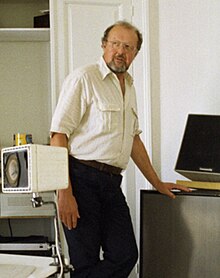Max Neuhaus
Max Neuhaus | |
|---|---|
 | |
| Background information | |
| Born | August 9, 1939 |
| Died | February 3, 2009 (aged 69) |
| Genres | Avant-garde, experimental |
| Occupation(s) | Public art, sound art, sound installation |
| Years active | 1957–2009 |
| Website | https://www.max-neuhaus.estate |
Max Neuhaus (August 9, 1939–February 3, 2009) was an American musician, composer and artist who was a noted interpreter of contemporary and experimental percussion music in the 1960s.[1] He went on to create numerous permanent and short-term sound installations in the four decades that followed.
Biography[]
Neuhaus was born on August 9, 1939 in Beaumont, Texas and attended high school in Houston. He studied percussion with Paul Price at the Manhattan School of Music, graduating with a master of music degree in 1962. He performed as a percussion soloist on concert tours throughout the United States with Pierre Boulez (1962-1963) and Karlheinz Stockhausen (1963-1964). In 1964 and 1965, he presented solo recitals in Carnegie Hall in New York City and in fiteeen major European cities. In 1966, he published on Mass Art Inc. four live realizations of John Cage's Fontana Mix (1958), an indeterminate graphic score originally intended for a tape piece, with or without additional instruments. Entitled Fontana Mix-Feed, Neuhaus' realizations employed controlled feedback generated by placing contact microphones on percussive instruments and hooking the microphones up to loudspeakers positioned directly opposite the instruments.
His work as a percussionist culminated in an album of contemporary solo percussion work, Electronics & Percussion - Five Realizations By Max Neuhaus, which he recorded for Columbia Masterworks in 1968, and was produced by David Behrman.
In 1968, he pursued a career as a contemporary artist by developing sound installations, using electronic or electroacoustic sounds which would emanate from a source within a particular space or location. He coined the term "sound installation" to describe his sound works which were neither music nor events. One piece called Times Square was built in 1977 beneath a grate on a traffic island in Manhattan where pedestrians would be "enveloped by a deeply resonant and mildly undulating drone, its tone suggestive of low-pitched chimes or church bells."[1] Other works included penny whistles heard underwater in swimming pools, electronic sounds within an arboretum and the modified sounds of listeners whistling tunes over public radio.
Permanent sound installations by Neuhaus are found in these locations:
- The Menil Collection, Houston, USA
- Synagogue Stommeln, Stommeln, Germany
- Promenade du Pin, Geneva, Switzerland
- Gewerbeschule Bern (gibb - Berufsfachschule), Bern, Switzerland
- Times Square, New York City, USA
- The Dia Art Foundation, Beacon, New York, USA[1]
- CAPC, musée d'art contemporain de Bordeaux, Bordeaux, France
- AOK Hessen – Beratungscenter Kassel-City, Kassel, Germany
- Castello di Rivoli, Torino, Italy
- Kunsthaus Graz, Graz, Austria
Personal life[]
Neuhaus was married with two daughters. He died of cancer in his then hometown of Maratea, Italy on February 3, 2009.[1]
References[]
- ^ Jump up to: a b c d Weber, Bruce (February 9, 2009). "Max Neuhaus, Who Made Aural Artwork, Dies at 69". New York Times. p. A20. Retrieved November 3, 2015.
Further reading[]
- Ammann, Jean-Christophe (1983). "Notes on Max Neuhaus". Max Neuhaus: Sound Installation [German, English]. Kunsthalle Basel.
- Cooke, Lynne, Karen Kelly and Barbara Schröder, eds. (2009). Max Neuhaus: Times Square, Time Piece Beacon. Dia Art Foundation.
- Danto, Arthur (March 4, 1991). "Max Neuhaus: Sound Works". The Nation.
- Eppley, Charles (May 2017). Soundsites: Max Neuhaus, Site-Specificity, and the Materiality of Sound as Place. Dissertation. Stony Brook University.
- Eppley, Charles (December 2017). "Times Square: Strategies and Contingencies of Preserving Sonic Art," Leonardo Music Journal.
- Goldstein, Malcolm (June 1964). "Neuhaus Realizations". The Village Voice.
- Johnson, Tom (October 6, 1976). "Creating the Context: Max Neuhaus". The Village Voice.
- La Barbara, Joan (October 1977). "Max Neuhaus: new sounds in natural settings". Musical America.
- Loock, Ulrich (2005). "Times Square, Max Neuhaus's Sound Work in New York City". Open: Cahier on Art in the Public Domain.
- Loock, Ulrich (2007). "The Time Piece for the Stommeln Synagogue". Max Neuhaus Time Piece Stomme. Pulheim: Der Bürgermeister.
- Murph, Megan (2013), Max Neuhaus and the Musical Avant-Garde. Thesis. Louisiana State University.
- Murph, Megan (2018). Max Neuhaus, R. Murray Schafer, and the Challenges of Noise. Dissertation. University of Kentucky.
- Rockwell, John (1983). All American Music: Composition in the Late Twentieth Century. New York: Alfred A. Knopf, Inc. pp. 145–53. ISBN 0-394-51163-8.
- Safran, Yehuda (December 2004). "Shaping Sound". Domus 876.
- Salzman, Eric (November 1968). "Max Neuhaus' Electronics and Percussion". HiFi Stereo Review.
- Strongin, Theodore (June 3, 1964). "Concert Is Given By Percussionist". New York Times.
- Tazzi, Pier Luigi (November 1997). "Constructed Sound: Max Neuhaus". Carte d'Arte Internazionale (Messina).
- Tomkins, Calvin (October 24, 1988). "HEAR". The New Yorker.
External links[]
https://www.max-neuhaus.estate
- Max Neuhaus papers, 1950s-1980 (Columbia University, Archival Collections: Rare Book and Manuscript Library)
- Max Neuhaus Website (Archive from June 26, 2018; accessed February 1, 2019)
- Auracle
- Dia Art Foundation: Times Square
- Dia Art Foundation: Time Piece Beacon
- Kunsthaus Graz: Time Piece Graz
- Max Neuhaus Papers at the Rare Book and Manuscript Library, Columbia University, New York, NY
- 1939 births
- 2009 deaths
- American installation artists
- Experimental composers
- American sound artists
- Male classical composers
- 20th-century American composers
- 20th-century American male musicians